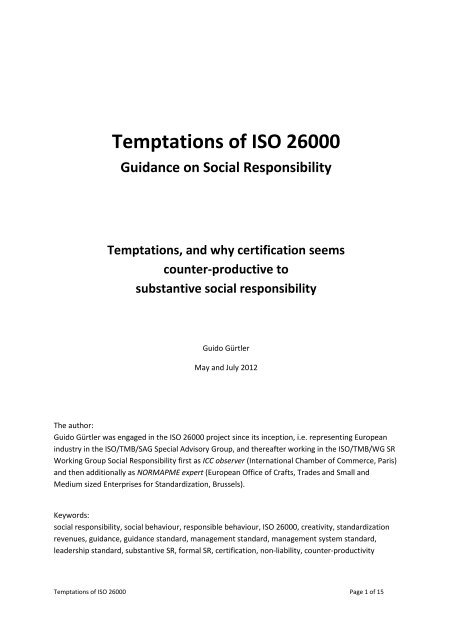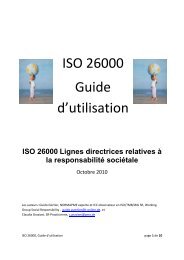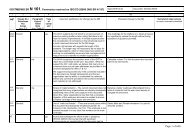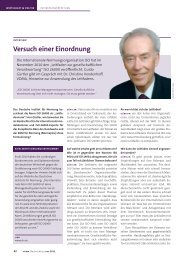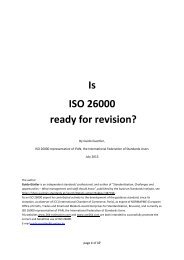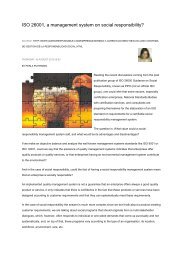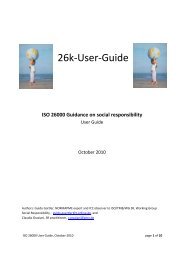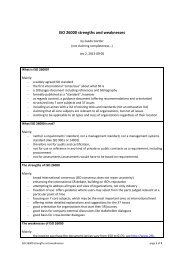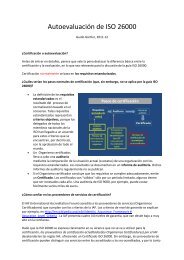Temptations of ISO 26000 Guidance on Social Responsibility ...
Temptations of ISO 26000 Guidance on Social Responsibility ...
Temptations of ISO 26000 Guidance on Social Responsibility ...
Create successful ePaper yourself
Turn your PDF publications into a flip-book with our unique Google optimized e-Paper software.
<str<strong>on</strong>g>Temptati<strong>on</strong>s</str<strong>on</strong>g> <str<strong>on</strong>g>of</str<strong>on</strong>g> <str<strong>on</strong>g>ISO</str<strong>on</strong>g> <str<strong>on</strong>g>26000</str<strong>on</strong>g><br />
<str<strong>on</strong>g>Guidance</str<strong>on</strong>g> <strong>on</strong> <strong>Social</strong> Resp<strong>on</strong>sibility<br />
<str<strong>on</strong>g>Temptati<strong>on</strong>s</str<strong>on</strong>g>, and why certificati<strong>on</strong> seems<br />
counter-productive to<br />
substantive social resp<strong>on</strong>sibility<br />
Guido Gürtler<br />
May and July 2012<br />
The author:<br />
Guido Gürtler was engaged in the <str<strong>on</strong>g>ISO</str<strong>on</strong>g> <str<strong>on</strong>g>26000</str<strong>on</strong>g> project since its incepti<strong>on</strong>, i.e. representing European<br />
industry in the <str<strong>on</strong>g>ISO</str<strong>on</strong>g>/TMB/SAG Special Advisory Group, and thereafter working in the <str<strong>on</strong>g>ISO</str<strong>on</strong>g>/TMB/WG SR<br />
Working Group <strong>Social</strong> Resp<strong>on</strong>sibility first as ICC observer (Internati<strong>on</strong>al Chamber <str<strong>on</strong>g>of</str<strong>on</strong>g> Commerce, Paris)<br />
and then additi<strong>on</strong>ally as NORMAPME expert (European Office <str<strong>on</strong>g>of</str<strong>on</strong>g> Crafts, Trades and Small and<br />
Medium sized Enterprises for Standardizati<strong>on</strong>, Brussels).<br />
Keywords:<br />
social resp<strong>on</strong>sibility, social behaviour, resp<strong>on</strong>sible behaviour, <str<strong>on</strong>g>ISO</str<strong>on</strong>g> <str<strong>on</strong>g>26000</str<strong>on</strong>g>, creativity, standardizati<strong>on</strong><br />
revenues, guidance, guidance standard, management standard, management system standard,<br />
leadership standard, substantive SR, formal SR, certificati<strong>on</strong>, n<strong>on</strong>-liability, counter-productivity<br />
<str<strong>on</strong>g>Temptati<strong>on</strong>s</str<strong>on</strong>g> <str<strong>on</strong>g>of</str<strong>on</strong>g> <str<strong>on</strong>g>ISO</str<strong>on</strong>g> <str<strong>on</strong>g>26000</str<strong>on</strong>g> Page 1 <str<strong>on</strong>g>of</str<strong>on</strong>g> 15
C<strong>on</strong>tent<br />
Pre-face ................................................................................................................................................... 3<br />
1 What is social resp<strong>on</strong>sibility? .......................................................................................................... 3<br />
2 <str<strong>on</strong>g>ISO</str<strong>on</strong>g>’s good intenti<strong>on</strong> ........................................................................................................................ 4<br />
3 The main temptati<strong>on</strong>s ..................................................................................................................... 5<br />
3.1 Nati<strong>on</strong>al Standards Bodies’ temptati<strong>on</strong> .................................................................................. 5<br />
3.2 <str<strong>on</strong>g>ISO</str<strong>on</strong>g>’s temptati<strong>on</strong>s .................................................................................................................... 5<br />
3.2.1 Creating a next bestseller................................................................................................ 6<br />
3.2.2 Enlarging the set <str<strong>on</strong>g>of</str<strong>on</strong>g> management standards .................................................................. 6<br />
3.3 Certifiers’ temptati<strong>on</strong>s ............................................................................................................ 7<br />
3.3.1 First certificati<strong>on</strong>s to <str<strong>on</strong>g>ISO</str<strong>on</strong>g> <str<strong>on</strong>g>26000</str<strong>on</strong>g> ...................................................................................... 7<br />
3.3.2 Creating copycat standards............................................................................................. 8<br />
3.3.3 Mixing <str<strong>on</strong>g>ISO</str<strong>on</strong>g> <str<strong>on</strong>g>26000</str<strong>on</strong>g> into other certifiable packages........................................................... 8<br />
3.3.4 Assessment...................................................................................................................... 8<br />
3.3.5 A questi<strong>on</strong> <str<strong>on</strong>g>of</str<strong>on</strong>g> ethics......................................................................................................... 9<br />
3.4 NGO’s temptati<strong>on</strong>s.................................................................................................................. 9<br />
3.5 Industry’s temptati<strong>on</strong>s ............................................................................................................ 9<br />
3.5.1 Avoiding Stakeholder dialogue........................................................................................ 9<br />
3.5.2 Giving too much trust.................................................................................................... 10<br />
3.5.3 “Delegating” a company’s own resp<strong>on</strong>sibility............................................................... 10<br />
3.5.4 Reducing creativity ........................................................................................................ 10<br />
3.6 C<strong>on</strong>sumer organizati<strong>on</strong>s’ temptati<strong>on</strong>s.................................................................................. 11<br />
3.7 C<strong>on</strong>sultants’ and trainers’ temptati<strong>on</strong>s................................................................................. 11<br />
3.8 Governments’ temptati<strong>on</strong>s ................................................................................................... 12<br />
3.9 Hidden agendas..................................................................................................................... 12<br />
4 N<strong>on</strong>-liability <str<strong>on</strong>g>of</str<strong>on</strong>g> certificati<strong>on</strong> bodies............................................................................................... 13<br />
5 The counter-productivity <str<strong>on</strong>g>of</str<strong>on</strong>g> SR certificates................................................................................... 13<br />
6 The way forward............................................................................................................................ 14<br />
<str<strong>on</strong>g>Temptati<strong>on</strong>s</str<strong>on</strong>g> <str<strong>on</strong>g>of</str<strong>on</strong>g> <str<strong>on</strong>g>ISO</str<strong>on</strong>g> <str<strong>on</strong>g>26000</str<strong>on</strong>g> Page 2 <str<strong>on</strong>g>of</str<strong>on</strong>g> 15
Pre-face<br />
“<str<strong>on</strong>g>ISO</str<strong>on</strong>g> <str<strong>on</strong>g>26000</str<strong>on</strong>g> <str<strong>on</strong>g>Guidance</str<strong>on</strong>g> <strong>on</strong> <strong>Social</strong> Resp<strong>on</strong>sibility" is an internati<strong>on</strong>al standard that <str<strong>on</strong>g>of</str<strong>on</strong>g>fers guidance <strong>on</strong><br />
social resp<strong>on</strong>sibility (SR) to organizati<strong>on</strong>s. <str<strong>on</strong>g>ISO</str<strong>on</strong>g> is the Internati<strong>on</strong>al Standardizati<strong>on</strong> Organisati<strong>on</strong>,<br />
Geneva/Switzerland.<br />
The present article puts bits and pieces together <strong>on</strong> how things have developed and may further<br />
develop. The described temptati<strong>on</strong>s are real. Some have already surrendered to them; others may<br />
follow. With this in mind it seems helpful to create greater awareness and thereby – hopefully – to<br />
minimize future temptati<strong>on</strong>s. This article introduces a distincti<strong>on</strong> between creativity-driven<br />
substantive SR and formal SR, which is represented by SR certificati<strong>on</strong>, and explains why certificati<strong>on</strong><br />
is counter-productive to SR.<br />
As a c<strong>on</strong>clusi<strong>on</strong> an easy to handle ‘way forward’ is <str<strong>on</strong>g>of</str<strong>on</strong>g>fered.<br />
1 What is social resp<strong>on</strong>sibility?<br />
<strong>Social</strong> resp<strong>on</strong>sibility (SR) is all about behaving in a socially resp<strong>on</strong>sible manner, towards all parts <str<strong>on</strong>g>of</str<strong>on</strong>g><br />
society. It is more than the <str<strong>on</strong>g>ISO</str<strong>on</strong>g> <str<strong>on</strong>g>26000</str<strong>on</strong>g> guidance <strong>on</strong> organizati<strong>on</strong>al governance, human rights, labour<br />
practices, the envir<strong>on</strong>ment, fair operating practices, c<strong>on</strong>sumer issues, and community involvement<br />
and development. SR is about behaving resp<strong>on</strong>sibly and c<strong>on</strong>tributing to societal development.<br />
SR is complex because societies differ and want to keep these differences, because it is diverse in<br />
substance, and because societies’ needs are dynamically varying over time.<br />
<strong>Social</strong> resp<strong>on</strong>sibility factors are interdependent<br />
and permanently changing/developing:<br />
climate income law<br />
ec<strong>on</strong>omy<br />
needs regulati<strong>on</strong><br />
populati<strong>on</strong><br />
health<br />
enforcement<br />
families local demands<br />
markets<br />
relati<strong>on</strong>s<br />
security community deficits<br />
… and many<br />
wealth<br />
others….<br />
workplace<br />
values<br />
How best to c<strong>on</strong>tribute?<br />
Figure 1 Dynamics <str<strong>on</strong>g>of</str<strong>on</strong>g> social resp<strong>on</strong>sibility<br />
SR materializes through c<strong>on</strong>crete acti<strong>on</strong>s/projects (i.e. c<strong>on</strong>tributi<strong>on</strong>s to society), by individual<br />
projects, tailored projects, staff social volunteering with leadership backing etc., by meeting local<br />
needs that are specific in substance and time.<br />
<str<strong>on</strong>g>Temptati<strong>on</strong>s</str<strong>on</strong>g> <str<strong>on</strong>g>of</str<strong>on</strong>g> <str<strong>on</strong>g>ISO</str<strong>on</strong>g> <str<strong>on</strong>g>26000</str<strong>on</strong>g> Page 3 <str<strong>on</strong>g>of</str<strong>on</strong>g> 15
SR develops where governments have secured the necessary minimum legislative framework for the<br />
protecti<strong>on</strong> <str<strong>on</strong>g>of</str<strong>on</strong>g> life, property and the envir<strong>on</strong>ment. SR cannot really unfold where governments fail.<br />
And it is not businesses or any other stakeholders’ task to substitute government acti<strong>on</strong>: nobody can<br />
replace government, particularly standardizati<strong>on</strong> and certificati<strong>on</strong> bodies.<br />
Finally, socially resp<strong>on</strong>sible behaviour is a precious commodity, must be lived, based <strong>on</strong> pers<strong>on</strong>al will;<br />
it is not something to be formally “managed" or "administered"; it is too precious to be devalued by<br />
believing that <strong>on</strong>e could be c<strong>on</strong>tent if all questi<strong>on</strong>s <str<strong>on</strong>g>of</str<strong>on</strong>g> a formal scheme had been checked.<br />
2 <str<strong>on</strong>g>ISO</str<strong>on</strong>g>’s good intenti<strong>on</strong><br />
A c<strong>on</strong>tributi<strong>on</strong> <str<strong>on</strong>g>of</str<strong>on</strong>g> 16 February 2012 to the <str<strong>on</strong>g>ISO</str<strong>on</strong>g> <str<strong>on</strong>g>26000</str<strong>on</strong>g> forum <strong>on</strong> LinkedIn reads:<br />
“Thousands <str<strong>on</strong>g>of</str<strong>on</strong>g> Chinese factory workers will be given the chance to detail the punishing<br />
c<strong>on</strong>diti<strong>on</strong>s <strong>on</strong> assembly lines producing Apple iPads and iPh<strong>on</strong>es, after the US company bowed<br />
to criticism and agreed to allow independent inspecti<strong>on</strong>s <str<strong>on</strong>g>of</str<strong>on</strong>g> its supply chain. Facing a growing<br />
scandal over the working c<strong>on</strong>diti<strong>on</strong>s <str<strong>on</strong>g>of</str<strong>on</strong>g> its factories, Apple has called in assessors from the<br />
same organisati<strong>on</strong> that was set up to stamp out sweatshops in the clothing industry more than a<br />
decade ago. The Independent.”<br />
This sounds pretty similar to the Nike case early this century, where exploited working c<strong>on</strong>diti<strong>on</strong>s<br />
were practiced in Asia, or to the Enr<strong>on</strong> and WorldCom cases where companies destroyed the pensi<strong>on</strong><br />
funds <str<strong>on</strong>g>of</str<strong>on</strong>g> their employees. These former cases gave reas<strong>on</strong> for <str<strong>on</strong>g>ISO</str<strong>on</strong>g>’s c<strong>on</strong>sumer policy committee,<br />
named <str<strong>on</strong>g>ISO</str<strong>on</strong>g> COPOLCO, to organize in 2002 a c<strong>on</strong>ference in Trinidad Tobago to investigate whether<br />
<str<strong>on</strong>g>ISO</str<strong>on</strong>g> should launch some standardizati<strong>on</strong> work in the area <str<strong>on</strong>g>of</str<strong>on</strong>g> social resp<strong>on</strong>sibility.<br />
Today, the discussi<strong>on</strong> <str<strong>on</strong>g>of</str<strong>on</strong>g> social resp<strong>on</strong>sibility (SR) is en vogue, and organizati<strong>on</strong>s realize much more<br />
than before the given benefits <str<strong>on</strong>g>of</str<strong>on</strong>g> SR behaviour. In many cases SR is seen as a part <str<strong>on</strong>g>of</str<strong>on</strong>g> sustainability.<br />
Lots <str<strong>on</strong>g>of</str<strong>on</strong>g> standards, reporting schemes and other guidelines have developed; <str<strong>on</strong>g>ISO</str<strong>on</strong>g> <str<strong>on</strong>g>26000</str<strong>on</strong>g> is just <strong>on</strong>e <str<strong>on</strong>g>of</str<strong>on</strong>g><br />
them. A big achievement <str<strong>on</strong>g>of</str<strong>on</strong>g> <str<strong>on</strong>g>ISO</str<strong>on</strong>g> <str<strong>on</strong>g>26000</str<strong>on</strong>g> is its c<strong>on</strong>tributi<strong>on</strong> to this internati<strong>on</strong>ally increasing debate.<br />
As menti<strong>on</strong>ed, societies are different, through their habits, languages, cultures, histories etc., and<br />
societies want to keep these differences. So, <strong>on</strong>e should not try to standardize societies. With this in<br />
mind, <str<strong>on</strong>g>ISO</str<strong>on</strong>g> followed a prudent approach in developing a n<strong>on</strong>-certifiable guidance standard that <str<strong>on</strong>g>of</str<strong>on</strong>g>fers<br />
recommendati<strong>on</strong>s, advice, proposals and orientati<strong>on</strong>, instead <str<strong>on</strong>g>of</str<strong>on</strong>g> developing a normal requirement<br />
standard.<br />
The <str<strong>on</strong>g>ISO</str<strong>on</strong>g> <str<strong>on</strong>g>26000</str<strong>on</strong>g>:2010 is a good achievement so far as it goes. It addresses the principles <str<strong>on</strong>g>of</str<strong>on</strong>g><br />
accountability, transparency, ethical behaviour, respect for: stakeholder interests, the rule <str<strong>on</strong>g>of</str<strong>on</strong>g> law,<br />
internati<strong>on</strong>al norms <str<strong>on</strong>g>of</str<strong>on</strong>g> behaviour, and human rights; it addresses the core subjects <str<strong>on</strong>g>of</str<strong>on</strong>g> organizati<strong>on</strong>al<br />
governance, human rights, labour practices, the envir<strong>on</strong>ment, fair operating practices, c<strong>on</strong>sumer<br />
issues, and community involvement and development; each core subject is subdivided into a number<br />
<str<strong>on</strong>g>of</str<strong>on</strong>g> issues from which an organisati<strong>on</strong> should select the <strong>on</strong>es judged relevant. The guidance standard<br />
claims to be applicable to all types and sizes <str<strong>on</strong>g>of</str<strong>on</strong>g> organizati<strong>on</strong>s regardless <str<strong>on</strong>g>of</str<strong>on</strong>g> their locati<strong>on</strong>. It provides<br />
recommendati<strong>on</strong>s <strong>on</strong> how to integrate a socially resp<strong>on</strong>sible behaviour into an organizati<strong>on</strong>. In its<br />
scope <strong>on</strong>e can read that it should be c<strong>on</strong>sidered complementary to other SR standards and that it<br />
<str<strong>on</strong>g>Temptati<strong>on</strong>s</str<strong>on</strong>g> <str<strong>on</strong>g>of</str<strong>on</strong>g> <str<strong>on</strong>g>ISO</str<strong>on</strong>g> <str<strong>on</strong>g>26000</str<strong>on</strong>g> Page 4 <str<strong>on</strong>g>of</str<strong>on</strong>g> 15
“…is not a management system standard. It is not intended or appropriate for certificati<strong>on</strong> purposes or<br />
regulatory or c<strong>on</strong>tractual use. Any <str<strong>on</strong>g>of</str<strong>on</strong>g>fer to certify, or claims to be certified, to <str<strong>on</strong>g>ISO</str<strong>on</strong>g> <str<strong>on</strong>g>26000</str<strong>on</strong>g> would be a<br />
misrepresentati<strong>on</strong> <str<strong>on</strong>g>of</str<strong>on</strong>g> the intent and purpose and a misuse <str<strong>on</strong>g>of</str<strong>on</strong>g> this Internati<strong>on</strong>al Standard. As this Internati<strong>on</strong>al<br />
Standard does not c<strong>on</strong>tain requirements, any such certificati<strong>on</strong> would not be a dem<strong>on</strong>strati<strong>on</strong> <str<strong>on</strong>g>of</str<strong>on</strong>g> c<strong>on</strong>formity<br />
with this Internati<strong>on</strong>al Standard.”<br />
However, in spite <str<strong>on</strong>g>of</str<strong>on</strong>g> such good achievements and clear words, the type guidance standard is <str<strong>on</strong>g>of</str<strong>on</strong>g>ten<br />
misc<strong>on</strong>ceived (there are not so many guidance standards yet) and social resp<strong>on</strong>sibility is a "new<br />
area" in the world <str<strong>on</strong>g>of</str<strong>on</strong>g> standardizati<strong>on</strong>, so that <str<strong>on</strong>g>ISO</str<strong>on</strong>g> <str<strong>on</strong>g>26000</str<strong>on</strong>g> inherits a significant potential for<br />
misc<strong>on</strong>cepti<strong>on</strong> and misuse.<br />
Standardizati<strong>on</strong> is also a business and business includes temptati<strong>on</strong>s. By analyzing the main<br />
temptati<strong>on</strong>s, this article intends to increase awareness and aims to minimize temptati<strong>on</strong>s, thus trying<br />
to c<strong>on</strong>tribute to the correct use and l<strong>on</strong>g-term success <str<strong>on</strong>g>of</str<strong>on</strong>g> <str<strong>on</strong>g>ISO</str<strong>on</strong>g> <str<strong>on</strong>g>26000</str<strong>on</strong>g>, wherever it is practically used.<br />
3 The main temptati<strong>on</strong>s<br />
3.1 Nati<strong>on</strong>al Standards Bodies’ temptati<strong>on</strong><br />
Standards bodies <str<strong>on</strong>g>of</str<strong>on</strong>g>fer the infrastructure for the necessary committee work where people meet to<br />
negotiate the c<strong>on</strong>tent <str<strong>on</strong>g>of</str<strong>on</strong>g> standards. The main part <str<strong>on</strong>g>of</str<strong>on</strong>g> the revenues <str<strong>on</strong>g>of</str<strong>on</strong>g> <str<strong>on</strong>g>ISO</str<strong>on</strong>g> member bodies (the<br />
nati<strong>on</strong>al standards bodies being members <str<strong>on</strong>g>of</str<strong>on</strong>g> <str<strong>on</strong>g>ISO</str<strong>on</strong>g>) comes from standards’ sales. This is a well proven<br />
and accepted model. <str<strong>on</strong>g>ISO</str<strong>on</strong>g> member bodies have the right to publish <str<strong>on</strong>g>ISO</str<strong>on</strong>g> standards as nati<strong>on</strong>al editi<strong>on</strong>s.<br />
<str<strong>on</strong>g>ISO</str<strong>on</strong>g> nati<strong>on</strong>al member bodies individually calculate the prices for “their” standards. Some seem to be<br />
tempted to set the price as high as possible: it is interesting to see that the prices for nati<strong>on</strong>al<br />
editi<strong>on</strong>s <str<strong>on</strong>g>of</str<strong>on</strong>g> <str<strong>on</strong>g>ISO</str<strong>on</strong>g> <str<strong>on</strong>g>26000</str<strong>on</strong>g> vary significantly from 30 € in South Africa and 31 € in Costa Rica up to 169,00<br />
€ in Finland and 171,00 € (223 US$) in the United States. Other countries’ prices can be found at<br />
http://www.26k-estimati<strong>on</strong>.com/html/best_prices_for_iso_<str<strong>on</strong>g>26000</str<strong>on</strong>g>.html#26kBestPrices (2012-05) .<br />
3.2 <str<strong>on</strong>g>ISO</str<strong>on</strong>g>’s temptati<strong>on</strong>s<br />
Author’s note: Since early July 2012 <str<strong>on</strong>g>ISO</str<strong>on</strong>g> has redesigned its website, so that the <str<strong>on</strong>g>ISO</str<strong>on</strong>g> related<br />
links d<strong>on</strong>'t work any l<strong>on</strong>ger. I assure that the quoted informati<strong>on</strong> was available under the<br />
menti<strong>on</strong>ed links. Now the guidance document <str<strong>on</strong>g>ISO</str<strong>on</strong>g> <str<strong>on</strong>g>26000</str<strong>on</strong>g> appears <strong>on</strong> the site<br />
http://www.iso.org/iso/home/standards/management-standards.htm (2012-06-03) in the<br />
group <str<strong>on</strong>g>of</str<strong>on</strong>g> "management system standard" as "<str<strong>on</strong>g>ISO</str<strong>on</strong>g> <str<strong>on</strong>g>26000</str<strong>on</strong>g> family – <strong>Social</strong> resp<strong>on</strong>sibility" and <strong>on</strong><br />
site http://www.iso.org/iso/home/standards/management-standards/iso<str<strong>on</strong>g>26000</str<strong>on</strong>g>.htm (2012-06-<br />
03) the statement can be found that the editi<strong>on</strong> <str<strong>on</strong>g>ISO</str<strong>on</strong>g> <str<strong>on</strong>g>26000</str<strong>on</strong>g>:2010 is not certifiable.<br />
This new grouping may fulfill certain purposes; however, this does not change the fact that <str<strong>on</strong>g>ISO</str<strong>on</strong>g><br />
<str<strong>on</strong>g>26000</str<strong>on</strong>g> <str<strong>on</strong>g>of</str<strong>on</strong>g>fers recommendati<strong>on</strong>s, advice, proposals, and orientati<strong>on</strong>, which <strong>on</strong>e may follow or<br />
not.<br />
<str<strong>on</strong>g>Temptati<strong>on</strong>s</str<strong>on</strong>g> <str<strong>on</strong>g>of</str<strong>on</strong>g> <str<strong>on</strong>g>ISO</str<strong>on</strong>g> <str<strong>on</strong>g>26000</str<strong>on</strong>g> Page 5 <str<strong>on</strong>g>of</str<strong>on</strong>g> 15
3.2.1 Creating a next bestseller<br />
The worldwide well-known bestseller is <str<strong>on</strong>g>ISO</str<strong>on</strong>g> 9000 Quality Management Systems. The WG SR (Working<br />
Group <strong>Social</strong> Resp<strong>on</strong>sibility) felt that <str<strong>on</strong>g>ISO</str<strong>on</strong>g> <str<strong>on</strong>g>26000</str<strong>on</strong>g> would be a good example where <str<strong>on</strong>g>ISO</str<strong>on</strong>g> and its member<br />
bodies could dem<strong>on</strong>strate their percepti<strong>on</strong> <str<strong>on</strong>g>of</str<strong>on</strong>g> social resp<strong>on</strong>sibility by providing the hundred pages<br />
document in electr<strong>on</strong>ic format for free, and in paper format for printing and shipping costs; feeling<br />
that this was not really damaging the budgets but could significantly enhance the proliferati<strong>on</strong> and<br />
use <str<strong>on</strong>g>of</str<strong>on</strong>g> the guidance standard the WG SR approached <str<strong>on</strong>g>ISO</str<strong>on</strong>g> twice, and <str<strong>on</strong>g>ISO</str<strong>on</strong>g> Council twice denied this<br />
request. So, <strong>on</strong>e can c<strong>on</strong>clude: a temptati<strong>on</strong> <str<strong>on</strong>g>of</str<strong>on</strong>g> generating additi<strong>on</strong>al revenues prevailed over an<br />
excepti<strong>on</strong> from the existing sales policy.<br />
Since this opportunity for dem<strong>on</strong>strating a socially relevant behaviour was not used it will be<br />
interesting to see in which other way <str<strong>on</strong>g>ISO</str<strong>on</strong>g> and its nati<strong>on</strong>al member bodies will <strong>on</strong>ce dem<strong>on</strong>strate their<br />
social resp<strong>on</strong>sibility. They satisfy the <str<strong>on</strong>g>ISO</str<strong>on</strong>g> <str<strong>on</strong>g>26000</str<strong>on</strong>g> definiti<strong>on</strong> <str<strong>on</strong>g>of</str<strong>on</strong>g> an “organizati<strong>on</strong>” and, as menti<strong>on</strong>ed,<br />
<str<strong>on</strong>g>ISO</str<strong>on</strong>g> <str<strong>on</strong>g>26000</str<strong>on</strong>g> addresses all types and sizes <str<strong>on</strong>g>of</str<strong>on</strong>g> organizati<strong>on</strong>s.<br />
3.2.2 Enlarging the set <str<strong>on</strong>g>of</str<strong>on</strong>g> management standards<br />
Sorry that this clause needs some more detail! The <str<strong>on</strong>g>ISO</str<strong>on</strong>g> COPOLCO (c<strong>on</strong>sumer policy committee)<br />
workshop in Trinidad, see http://www.iso.org/iso/c<strong>on</strong>ferences.htm?llNodeId=22288&llVolId=-2000<br />
(2012-05), took place in June 2002, was attended by nearly <strong>on</strong>e hundred c<strong>on</strong>sumer representatives<br />
and two industry representatives. In the resulting report <strong>on</strong>e can read:<br />
“viii. The positi<strong>on</strong> taken in this report is that... <str<strong>on</strong>g>ISO</str<strong>on</strong>g> as an organizati<strong>on</strong> is well positi<strong>on</strong>ed to take leadership<br />
with respect to the development <str<strong>on</strong>g>of</str<strong>on</strong>g> voluntary <str<strong>on</strong>g>ISO</str<strong>on</strong>g> Corporate Resp<strong>on</strong>sibility Management Systems<br />
Standards (CR MSSs)… The Working Group c<strong>on</strong>cludes that, from a c<strong>on</strong>sumer perspective, <str<strong>on</strong>g>ISO</str<strong>on</strong>g> CR MSSs<br />
are both desirable and feasible.”….<br />
…Key elements <str<strong>on</strong>g>of</str<strong>on</strong>g> <str<strong>on</strong>g>ISO</str<strong>on</strong>g> CR MSSs include commitment to the c<strong>on</strong>cept <str<strong>on</strong>g>of</str<strong>on</strong>g> c<strong>on</strong>tinual improvement (as with<br />
<str<strong>on</strong>g>ISO</str<strong>on</strong>g> 9000 and <str<strong>on</strong>g>ISO</str<strong>on</strong>g> 14000 MSSs), commitment to the c<strong>on</strong>cept <str<strong>on</strong>g>of</str<strong>on</strong>g> stakeholder engagement, and commitment<br />
to transparent, accountable reporting <strong>on</strong> CR initiatives to a firm’s stakeholders and the greater public.”<br />
Source: cop2002summary.pdf from the “Executive summary…” at<br />
http://www.iso.org/iso/c<strong>on</strong>ferences.htm?llNodeId=22288&llVolId=-2000 (2012-03)<br />
In brief, the c<strong>on</strong>sumer community <str<strong>on</strong>g>of</str<strong>on</strong>g> <str<strong>on</strong>g>ISO</str<strong>on</strong>g> wanted to see the development <str<strong>on</strong>g>of</str<strong>on</strong>g> a classical certifiable<br />
management system standard. However, the subsequently installed SAG (Special Advisory Group,<br />
reporting to the <str<strong>on</strong>g>ISO</str<strong>on</strong>g>/TMB Technical Management Board) came to a different c<strong>on</strong>clusi<strong>on</strong>:<br />
“<str<strong>on</strong>g>ISO</str<strong>on</strong>g> should <strong>on</strong>ly proceed if:<br />
….<br />
6. <str<strong>on</strong>g>ISO</str<strong>on</strong>g> recognizes that, due to the complexity and fast-evolving nature <str<strong>on</strong>g>of</str<strong>on</strong>g> the subject, it is<br />
not feasible to harm<strong>on</strong>ize substantive social resp<strong>on</strong>sibility commitments. ..”;<br />
and further:<br />
“What should be the scope <str<strong>on</strong>g>of</str<strong>on</strong>g> the work and the types <str<strong>on</strong>g>of</str<strong>on</strong>g> deliverables?<br />
A guidance document, and therefore not a specificati<strong>on</strong> document against which c<strong>on</strong>formity can<br />
be assessed.”<br />
<str<strong>on</strong>g>Temptati<strong>on</strong>s</str<strong>on</strong>g> <str<strong>on</strong>g>of</str<strong>on</strong>g> <str<strong>on</strong>g>ISO</str<strong>on</strong>g> <str<strong>on</strong>g>26000</str<strong>on</strong>g> Page 6 <str<strong>on</strong>g>of</str<strong>on</strong>g> 15
Source: <str<strong>on</strong>g>ISO</str<strong>on</strong>g>/TMB AG CSR N32, Recommendati<strong>on</strong>s to the <str<strong>on</strong>g>ISO</str<strong>on</strong>g> TMB, April 2004<br />
In brief: the SAG recommendati<strong>on</strong> was to develop a guidance document and, since <str<strong>on</strong>g>ISO</str<strong>on</strong>g> documents<br />
are standards, most experts’ percepti<strong>on</strong> and trust was that there was a guidance standard to<br />
develop.<br />
In June 2004 an <str<strong>on</strong>g>ISO</str<strong>on</strong>g> c<strong>on</strong>ference took place in Stockholm and followed this recommendati<strong>on</strong>. <str<strong>on</strong>g>ISO</str<strong>on</strong>g><br />
Central Secretariat developed the "New Work Item Proposal", which is the project descripti<strong>on</strong>. It<br />
clarifies:<br />
“4 Type <str<strong>on</strong>g>of</str<strong>on</strong>g> standard<br />
The document shall be an <str<strong>on</strong>g>ISO</str<strong>on</strong>g> standard providing guidance and shall not be intended for thirdparty<br />
certificati<strong>on</strong>.“<br />
Source: New work item proposal - <strong>Social</strong> Resp<strong>on</strong>sibility, <str<strong>on</strong>g>ISO</str<strong>on</strong>g>/TMB document <str<strong>on</strong>g>of</str<strong>on</strong>g> 2004-10-07.<br />
Having menti<strong>on</strong>ed this, it was clear to the majority <str<strong>on</strong>g>of</str<strong>on</strong>g> experts that they are developing a guidance<br />
standard. Somewhat surprisingly, <strong>on</strong>e could find in January 2012 this new grouping <strong>on</strong> <str<strong>on</strong>g>ISO</str<strong>on</strong>g>’s<br />
homepage http://www.iso.org/iso/home.html (2012-05):<br />
Management and leadership standards<br />
<str<strong>on</strong>g>ISO</str<strong>on</strong>g> <str<strong>on</strong>g>26000</str<strong>on</strong>g> - <strong>Social</strong> resp<strong>on</strong>sibility<br />
<str<strong>on</strong>g>ISO</str<strong>on</strong>g> 31000 - Risk management<br />
Management system basics | Auditing<br />
<str<strong>on</strong>g>ISO</str<strong>on</strong>g> 50001 - Energy management<br />
<str<strong>on</strong>g>ISO</str<strong>on</strong>g> 9000 - Quality management<br />
<str<strong>on</strong>g>ISO</str<strong>on</strong>g> 14000 - Envir<strong>on</strong>mental management Certificati<strong>on</strong> | Complaints<br />
All <str<strong>on</strong>g>of</str<strong>on</strong>g> a sudden, by the end <str<strong>on</strong>g>of</str<strong>on</strong>g> 2011 the guidance standard <str<strong>on</strong>g>ISO</str<strong>on</strong>g> <str<strong>on</strong>g>26000</str<strong>on</strong>g> was included in this new group<br />
<str<strong>on</strong>g>of</str<strong>on</strong>g> management and leadership standards. However, the c<strong>on</strong>tent <str<strong>on</strong>g>of</str<strong>on</strong>g> <str<strong>on</strong>g>ISO</str<strong>on</strong>g> <str<strong>on</strong>g>26000</str<strong>on</strong>g> has not changed: it<br />
c<strong>on</strong>tinues to provide guidance.<br />
Since the other examples in this new grouping carry the term “management” in their title, other than<br />
<str<strong>on</strong>g>ISO</str<strong>on</strong>g> <str<strong>on</strong>g>26000</str<strong>on</strong>g>, it is logical that <str<strong>on</strong>g>ISO</str<strong>on</strong>g> <str<strong>on</strong>g>26000</str<strong>on</strong>g> is now a "leadership standard". It is c<strong>on</strong>sistent with this logic<br />
that further down <strong>on</strong> the <str<strong>on</strong>g>ISO</str<strong>on</strong>g> website it is emphasized that <str<strong>on</strong>g>ISO</str<strong>on</strong>g> <str<strong>on</strong>g>26000</str<strong>on</strong>g> is not certifiable, in c<strong>on</strong>trast to<br />
management standards or management system standards.<br />
3.3 Certifiers’ temptati<strong>on</strong>s<br />
Certificati<strong>on</strong> bodies are companies and need to gain revenues like any other companies. Their<br />
business is, am<strong>on</strong>g others, selling auditing and certificates.<br />
3.3.1 First certificati<strong>on</strong>s to <str<strong>on</strong>g>ISO</str<strong>on</strong>g> <str<strong>on</strong>g>26000</str<strong>on</strong>g><br />
Since certificati<strong>on</strong> is a good business <strong>on</strong>e can try to ignore the clear statement in the scope <str<strong>on</strong>g>of</str<strong>on</strong>g> <str<strong>on</strong>g>ISO</str<strong>on</strong>g><br />
<str<strong>on</strong>g>26000</str<strong>on</strong>g> that this guidance standard is not for certificati<strong>on</strong>. Some certifiers were tempted this way and<br />
welcomed the guidance standard as a new business ground, particularly in view <str<strong>on</strong>g>of</str<strong>on</strong>g> periodic recertificati<strong>on</strong>s<br />
as they are practiced in the area <str<strong>on</strong>g>of</str<strong>on</strong>g> management system standards like <str<strong>on</strong>g>ISO</str<strong>on</strong>g> 9001. A<br />
H<strong>on</strong>g K<strong>on</strong>g-based certifier issued an <str<strong>on</strong>g>ISO</str<strong>on</strong>g> <str<strong>on</strong>g>26000</str<strong>on</strong>g> certificate <strong>on</strong> the basis <str<strong>on</strong>g>of</str<strong>on</strong>g> the <str<strong>on</strong>g>ISO</str<strong>on</strong>g> <str<strong>on</strong>g>26000</str<strong>on</strong>g> Working<br />
Draft while already this draft standard said clearly that it was not for certificati<strong>on</strong>, and as a working<br />
<str<strong>on</strong>g>Temptati<strong>on</strong>s</str<strong>on</strong>g> <str<strong>on</strong>g>of</str<strong>on</strong>g> <str<strong>on</strong>g>ISO</str<strong>on</strong>g> <str<strong>on</strong>g>26000</str<strong>on</strong>g> Page 7 <str<strong>on</strong>g>of</str<strong>on</strong>g> 15
document was still being discussed in the working group. A Swiss certifier issued an <str<strong>on</strong>g>ISO</str<strong>on</strong>g> <str<strong>on</strong>g>26000</str<strong>on</strong>g><br />
certificate several m<strong>on</strong>ths before the <str<strong>on</strong>g>ISO</str<strong>on</strong>g> <str<strong>on</strong>g>26000</str<strong>on</strong>g> publicati<strong>on</strong> date.<br />
Such misc<strong>on</strong>cepti<strong>on</strong>s <str<strong>on</strong>g>of</str<strong>on</strong>g> the guidance standard alarmed <str<strong>on</strong>g>ISO</str<strong>on</strong>g>: at the end <str<strong>on</strong>g>of</str<strong>on</strong>g> 2010 a press release was<br />
published with the title "It's crystal clear. No certificati<strong>on</strong> to <str<strong>on</strong>g>ISO</str<strong>on</strong>g> <str<strong>on</strong>g>26000</str<strong>on</strong>g> guidance <strong>on</strong> social<br />
resp<strong>on</strong>sibility." See http://www.iso.org/iso/pressrelease.htm?refid=Ref1378 (2012-05).<br />
3.3.2 Creating copycat standards<br />
However, the temptati<strong>on</strong> <str<strong>on</strong>g>of</str<strong>on</strong>g> creating an <str<strong>on</strong>g>ISO</str<strong>on</strong>g> <str<strong>on</strong>g>26000</str<strong>on</strong>g> certificati<strong>on</strong> business still seems to be too big.<br />
Several <str<strong>on</strong>g>ISO</str<strong>on</strong>g> member bodies issued their own – <str<strong>on</strong>g>of</str<strong>on</strong>g> course certifiable – social resp<strong>on</strong>sibility standards.<br />
Prominent examples are Spain with its RS 10 standard, Austria with its ONR 192500, and Denmark<br />
with its DS 49001. A most recent development is the publicati<strong>on</strong> <str<strong>on</strong>g>of</str<strong>on</strong>g> an "IQNet SR 10” standard. IQNet<br />
is an organisati<strong>on</strong> in the area <str<strong>on</strong>g>of</str<strong>on</strong>g> quality management certificati<strong>on</strong> and cares for the mutual<br />
recogniti<strong>on</strong> <str<strong>on</strong>g>of</str<strong>on</strong>g> certificates issued by its member bodies. It seems to be more than interesting how this<br />
private standard developed because a c<strong>on</strong>sensus process with inclusi<strong>on</strong> <str<strong>on</strong>g>of</str<strong>on</strong>g> all stakeholders did not<br />
take place. First, <strong>on</strong>e should know that at least 16 out <str<strong>on</strong>g>of</str<strong>on</strong>g> 36 IQNet members are also <str<strong>on</strong>g>ISO</str<strong>on</strong>g> member<br />
bodies. Sec<strong>on</strong>dly, <strong>on</strong>e <str<strong>on</strong>g>of</str<strong>on</strong>g> these 16 members developed at nati<strong>on</strong>al level a certifiable social<br />
resp<strong>on</strong>sibility standard, outside the normal nati<strong>on</strong>al c<strong>on</strong>sensus process, and <str<strong>on</strong>g>of</str<strong>on</strong>g>fered the document as<br />
input to IQNet’s work. Thirdly, IQNet transposed this nati<strong>on</strong>al document into its "SR 10” standard and<br />
claims that it is based <strong>on</strong> <str<strong>on</strong>g>ISO</str<strong>on</strong>g> <str<strong>on</strong>g>26000</str<strong>on</strong>g>.<br />
One can call these standards copycat standards because they, more or less, copy the c<strong>on</strong>tent <str<strong>on</strong>g>of</str<strong>on</strong>g> <str<strong>on</strong>g>ISO</str<strong>on</strong>g><br />
<str<strong>on</strong>g>26000</str<strong>on</strong>g>, with the intent however to change voluntary guidance into certifiable requirements.<br />
3.3.3 Mixing <str<strong>on</strong>g>ISO</str<strong>on</strong>g> <str<strong>on</strong>g>26000</str<strong>on</strong>g> into other certifiable packages<br />
Another temptati<strong>on</strong> is to mix the <str<strong>on</strong>g>ISO</str<strong>on</strong>g> <str<strong>on</strong>g>26000</str<strong>on</strong>g> guidance standard into other certifiable packages and<br />
advertise this as selling SR certificati<strong>on</strong> as a cheap add-<strong>on</strong> to already practiced management system<br />
standards audits and certificati<strong>on</strong>s.<br />
At first glance this may seem attractive; however, it can be c<strong>on</strong>sidered the same kind <str<strong>on</strong>g>of</str<strong>on</strong>g> misuse as to<br />
certify directly to <str<strong>on</strong>g>ISO</str<strong>on</strong>g> <str<strong>on</strong>g>26000</str<strong>on</strong>g>.<br />
3.3.4 Assessment<br />
While recognizing that <str<strong>on</strong>g>ISO</str<strong>on</strong>g> <str<strong>on</strong>g>26000</str<strong>on</strong>g> does not c<strong>on</strong>tain requirements and is thereby not certifiable,<br />
several certificati<strong>on</strong> bodies believe it is clever to <str<strong>on</strong>g>of</str<strong>on</strong>g>fer instead an assessment. Particularly small and<br />
medium sized enterprises may not know the exact difference between certificati<strong>on</strong> and assessment.<br />
Therefore, NORMAPME (the European organisati<strong>on</strong> that cares for standardizati<strong>on</strong> issues <str<strong>on</strong>g>of</str<strong>on</strong>g> small and<br />
medium sized enterprises) published in July 2011 a “NORMAPME <str<strong>on</strong>g>ISO</str<strong>on</strong>g> <str<strong>on</strong>g>26000</str<strong>on</strong>g> user guide for European<br />
SMEs" that addresses the assessment questi<strong>on</strong> this way:<br />
“An assessment would need to score the <str<strong>on</strong>g>ISO</str<strong>on</strong>g> <str<strong>on</strong>g>26000</str<strong>on</strong>g> issues (e.g. to what degree the guidance <strong>on</strong> a<br />
particular issue is followed) and would thereby transpose the guidance into a measurable<br />
requirement. Particularly, SMEs should be aware <str<strong>on</strong>g>of</str<strong>on</strong>g> this because certificati<strong>on</strong> bodies may <str<strong>on</strong>g>of</str<strong>on</strong>g>fer<br />
assessment…”.<br />
<str<strong>on</strong>g>Temptati<strong>on</strong>s</str<strong>on</strong>g> <str<strong>on</strong>g>of</str<strong>on</strong>g> <str<strong>on</strong>g>ISO</str<strong>on</strong>g> <str<strong>on</strong>g>26000</str<strong>on</strong>g> Page 8 <str<strong>on</strong>g>of</str<strong>on</strong>g> 15
Source: see http://www.normapme.eu/en/page/45/corporate-social-resp<strong>on</strong>sibility (2012-05)<br />
and there the NORMAPME <str<strong>on</strong>g>ISO</str<strong>on</strong>g> <str<strong>on</strong>g>26000</str<strong>on</strong>g> user guide in various languages.<br />
Of course, assessment is a service, which has to be paid for!<br />
3.3.5 A questi<strong>on</strong> <str<strong>on</strong>g>of</str<strong>on</strong>g> ethics<br />
Here, an important questi<strong>on</strong> comes up: Is this an ethically resp<strong>on</strong>sible behaviour, and thereby a<br />
socially resp<strong>on</strong>sible behaviour? <str<strong>on</strong>g>ISO</str<strong>on</strong>g> <str<strong>on</strong>g>26000</str<strong>on</strong>g> is intenti<strong>on</strong>ally a n<strong>on</strong>-certifiable guidance standard,<br />
without requirements, which <str<strong>on</strong>g>of</str<strong>on</strong>g>fers recommendati<strong>on</strong>s, advice, proposals, and orientati<strong>on</strong>. Users may<br />
select the issues, which they judge relevant for their organizati<strong>on</strong>, and how they may c<strong>on</strong>tribute to<br />
the development <str<strong>on</strong>g>of</str<strong>on</strong>g> their society. Is it an ethical behaviour to change this intended freedom into a<br />
certifiable standard where the same <str<strong>on</strong>g>ISO</str<strong>on</strong>g> <str<strong>on</strong>g>26000</str<strong>on</strong>g> issues are transformed into requirements? It seems<br />
obvious that the answer does not need to be expressed explicitly. Certificati<strong>on</strong> business seems to<br />
prevail; Romans <str<strong>on</strong>g>of</str<strong>on</strong>g> antiquity said “pecunia n<strong>on</strong> olet” (m<strong>on</strong>ey doesn’t stink).<br />
This leads to another questi<strong>on</strong>: What about the qualificati<strong>on</strong> <str<strong>on</strong>g>of</str<strong>on</strong>g> certifiers in regard to their own social<br />
resp<strong>on</strong>sibility? Wouldn’t this be the right moment to request from certifiers evidence that they<br />
qualify by dem<strong>on</strong>strating their own social resp<strong>on</strong>sibility, i.e. by using <str<strong>on</strong>g>ISO</str<strong>on</strong>g> <str<strong>on</strong>g>26000</str<strong>on</strong>g> in their own<br />
organizati<strong>on</strong>s, including publicati<strong>on</strong> <str<strong>on</strong>g>of</str<strong>on</strong>g> an adequate statement <str<strong>on</strong>g>of</str<strong>on</strong>g> use as recommended by <str<strong>on</strong>g>ISO</str<strong>on</strong>g>?<br />
3.4 NGO’s temptati<strong>on</strong>s<br />
N<strong>on</strong>-governmental organizati<strong>on</strong>s may also be tempted. For example, Human Rights NGOs, as well as<br />
Envir<strong>on</strong>ment NGOs, may very much feel tempted to sell their own “assessments” to companies and<br />
other types <str<strong>on</strong>g>of</str<strong>on</strong>g> organizati<strong>on</strong>s. In absence <str<strong>on</strong>g>of</str<strong>on</strong>g> a formal certificati<strong>on</strong> scheme for <str<strong>on</strong>g>ISO</str<strong>on</strong>g> <str<strong>on</strong>g>26000</str<strong>on</strong>g>, e.g. Amnesty<br />
Internati<strong>on</strong>al may think about <str<strong>on</strong>g>of</str<strong>on</strong>g>fering services, which “prove” that your organizati<strong>on</strong> is not<br />
exploiting its workers. This potentially new business for NGOs might reach a c<strong>on</strong>siderable volume;<br />
however, like other services, it would also be revenue-oriented and violate the spirit and intent <str<strong>on</strong>g>of</str<strong>on</strong>g><br />
<str<strong>on</strong>g>ISO</str<strong>on</strong>g> <str<strong>on</strong>g>26000</str<strong>on</strong>g>, which can – as just menti<strong>on</strong>ed – be easily and self-resp<strong>on</strong>sibly used without engaging<br />
external parties.<br />
Like a formal certificate, an NGO assessment would also not ex<strong>on</strong>erate in any case <str<strong>on</strong>g>of</str<strong>on</strong>g> lawsuit.<br />
3.5 Industry’s temptati<strong>on</strong>s<br />
Industry is the by far the largest <str<strong>on</strong>g>ISO</str<strong>on</strong>g> <str<strong>on</strong>g>26000</str<strong>on</strong>g> user group. Looking back in history, certificati<strong>on</strong> to the<br />
quality management system standard <str<strong>on</strong>g>ISO</str<strong>on</strong>g> 9000 was first believed to create a differentiati<strong>on</strong> in<br />
competiti<strong>on</strong>. Companies certified to <str<strong>on</strong>g>ISO</str<strong>on</strong>g> 9000 were thought to be better placed. Not so today when<br />
all have the same certificate! Will business now make the same step with SR certificati<strong>on</strong>? To <str<strong>on</strong>g>ISO</str<strong>on</strong>g><br />
<str<strong>on</strong>g>26000</str<strong>on</strong>g> or to any <str<strong>on</strong>g>of</str<strong>on</strong>g> the copycat standards? It seems worthwhile to highlight some key points.<br />
3.5.1 Avoiding Stakeholder dialogue<br />
Today, the press increasingly emphasizes that companies should be aware <str<strong>on</strong>g>of</str<strong>on</strong>g> their "social license to<br />
operate" and that SR certificati<strong>on</strong> could help minimize social risks. There is much truth in this, and<br />
industry in general should feel encouraged to intensify the dialogue with all stakeholders <str<strong>on</strong>g>of</str<strong>on</strong>g> society.<br />
<str<strong>on</strong>g>Temptati<strong>on</strong>s</str<strong>on</strong>g> <str<strong>on</strong>g>of</str<strong>on</strong>g> <str<strong>on</strong>g>ISO</str<strong>on</strong>g> <str<strong>on</strong>g>26000</str<strong>on</strong>g> Page 9 <str<strong>on</strong>g>of</str<strong>on</strong>g> 15
"Stakeholder dialogue" is a key issue and includes company-internal and company-external SR<br />
related acti<strong>on</strong>s and provisi<strong>on</strong>s, discussi<strong>on</strong> <str<strong>on</strong>g>of</str<strong>on</strong>g> societies’ current problems and needs, possible acti<strong>on</strong>s<br />
etc. Substantive SR addresses such practical and actual items while certificati<strong>on</strong> can <strong>on</strong>ly be<br />
c<strong>on</strong>sidered as formal SR, as menti<strong>on</strong>ed: a snapshot at a particular point in time. The big temptati<strong>on</strong><br />
also in industry is to ignore this difference between substantive and formal SR and stick <strong>on</strong>ly to the<br />
formal <strong>on</strong>e.<br />
Currently there is an <strong>on</strong>going discussi<strong>on</strong> <str<strong>on</strong>g>of</str<strong>on</strong>g> another <str<strong>on</strong>g>ISO</str<strong>on</strong>g> guidance standard <strong>on</strong> customers complaints<br />
handling, <str<strong>on</strong>g>ISO</str<strong>on</strong>g> 10002, which up to now is not certifiable. The pros and c<strong>on</strong>s <str<strong>on</strong>g>of</str<strong>on</strong>g> certificati<strong>on</strong> are<br />
discussed in document “CWO CCV 12-16b background paper <str<strong>on</strong>g>ISO</str<strong>on</strong>g> 10002.pdf”. As <strong>on</strong>e <str<strong>on</strong>g>of</str<strong>on</strong>g> the<br />
disadvantages when changing <str<strong>on</strong>g>ISO</str<strong>on</strong>g> 10002 into a certifiable management system standard <strong>on</strong>e can<br />
read:<br />
“Change <str<strong>on</strong>g>of</str<strong>on</strong>g> focus: If top management takes the view that being certified against the <str<strong>on</strong>g>ISO</str<strong>on</strong>g><br />
specificati<strong>on</strong> is all they need to do, then the focus could switch away from trying to resolve<br />
c<strong>on</strong>sumer issues to a paradigm based <strong>on</strong> going to the procedural steps in the standard. The<br />
certificati<strong>on</strong> becomes an end in itself rather than an <strong>on</strong>going benchmark <str<strong>on</strong>g>of</str<strong>on</strong>g> performance; it does<br />
not necessarily lead to better service".<br />
Applying this logic to stakeholder dialogue, it can be c<strong>on</strong>cluded that certificati<strong>on</strong> includes a<br />
temptati<strong>on</strong> to give less importance to an active stakeholder dialogue, a most essential part <str<strong>on</strong>g>of</str<strong>on</strong>g><br />
substantive SR.<br />
3.5.2 Giving too much trust<br />
Industry may be tempted to trust too much in certificates. How many falsificati<strong>on</strong>s have been seen<br />
already? Of course, there are no reliable statistics. However, it is well known that there is no problem<br />
in issuing a faked piece <str<strong>on</strong>g>of</str<strong>on</strong>g> paper. Some certificati<strong>on</strong> bodies have lots <str<strong>on</strong>g>of</str<strong>on</strong>g> experience in this regard with<br />
e.g. Asian countries. As a possibly extreme example: it was reported that India children disappeared<br />
instantaneously from a quarry as so<strong>on</strong> as the inspector arrived…<br />
Further, can <strong>on</strong>e rely <strong>on</strong> the liability <str<strong>on</strong>g>of</str<strong>on</strong>g> certificati<strong>on</strong> bodies? No, it should be emphasized that<br />
certificates do not ex<strong>on</strong>erate in event <str<strong>on</strong>g>of</str<strong>on</strong>g> a lawsuit, see more details further down.<br />
3.5.3 “Delegating” a company’s own resp<strong>on</strong>sibility<br />
Companies may be tempted to delegate resp<strong>on</strong>sibility, e.g. by requiring a general SR certificate or a<br />
particular <str<strong>on</strong>g>ISO</str<strong>on</strong>g> <str<strong>on</strong>g>26000</str<strong>on</strong>g> certificate from business partners in their supply chain. Such certificates would<br />
not ex<strong>on</strong>erate either; they would rather have the effect <str<strong>on</strong>g>of</str<strong>on</strong>g> luring management into a false sense <str<strong>on</strong>g>of</str<strong>on</strong>g><br />
security because their own resp<strong>on</strong>sibility remains unchanged.<br />
3.5.4 Reducing creativity<br />
This is a very problematic item with high leverage because managers may tend to believe that they<br />
have d<strong>on</strong>e everything needed with regard to c<strong>on</strong>tributi<strong>on</strong>s to societal development. The press shows<br />
these managers fall from grace: certificate held in hand. The big temptati<strong>on</strong> <str<strong>on</strong>g>of</str<strong>on</strong>g> a certificate is to<br />
reduce creative thinking. The worst I've ever heard in this c<strong>on</strong>text was “No, no, we are proud <str<strong>on</strong>g>of</str<strong>on</strong>g> this<br />
certificate because this way we get rid <str<strong>on</strong>g>of</str<strong>on</strong>g> all external discussi<strong>on</strong>s!”<br />
<str<strong>on</strong>g>Temptati<strong>on</strong>s</str<strong>on</strong>g> <str<strong>on</strong>g>of</str<strong>on</strong>g> <str<strong>on</strong>g>ISO</str<strong>on</strong>g> <str<strong>on</strong>g>26000</str<strong>on</strong>g> Page 10 <str<strong>on</strong>g>of</str<strong>on</strong>g> 15
If industry at large takes the route <str<strong>on</strong>g>of</str<strong>on</strong>g> substantive SR the development <str<strong>on</strong>g>of</str<strong>on</strong>g> societies will be significantly<br />
enriched, not so if SR is reduced to spotlight observati<strong>on</strong>s, i.e. certificati<strong>on</strong> and formal SR.<br />
3.6 C<strong>on</strong>sumer organizati<strong>on</strong>s’ temptati<strong>on</strong>s<br />
As menti<strong>on</strong>ed, the <str<strong>on</strong>g>ISO</str<strong>on</strong>g> <str<strong>on</strong>g>26000</str<strong>on</strong>g> project was a c<strong>on</strong>sumer initiative. C<strong>on</strong>sumer organizati<strong>on</strong>s are known<br />
for their vigilance and they do a lot <str<strong>on</strong>g>of</str<strong>on</strong>g> good things for the world’s citizens.<br />
What was the c<strong>on</strong>sumers’ positi<strong>on</strong>? The working group <strong>on</strong> the <str<strong>on</strong>g>ISO</str<strong>on</strong>g> <str<strong>on</strong>g>26000</str<strong>on</strong>g> project was preceded by a<br />
"special advisory group" where the stakeholders industry, labour, government, NGOs, c<strong>on</strong>sumers,<br />
and services/research worked <strong>on</strong> the questi<strong>on</strong> whether <str<strong>on</strong>g>ISO</str<strong>on</strong>g> should develop a social resp<strong>on</strong>sibility<br />
standard at all. While NGOs and c<strong>on</strong>sumers clearly postulated a certifiable management system<br />
standard like <str<strong>on</strong>g>ISO</str<strong>on</strong>g> 9001, industry, labour, and government clearly expressed that they would prefer a<br />
guidance document and would not agree to any certifiable standard. Negotiati<strong>on</strong>s <strong>on</strong> this issue<br />
c<strong>on</strong>cluded that a c<strong>on</strong>sensus (not unanimity) was possible <strong>on</strong> the development <str<strong>on</strong>g>of</str<strong>on</strong>g> a guidance<br />
standard.<br />
It remains c<strong>on</strong>sumer organizati<strong>on</strong>s’ orientati<strong>on</strong> that it would be best to label all c<strong>on</strong>sumer products<br />
with all possible labels. It remains a huge temptati<strong>on</strong> to apply such thinking also to the area <str<strong>on</strong>g>of</str<strong>on</strong>g> social<br />
resp<strong>on</strong>sibility. However, falling victim to this would cause a real drawback to the promoti<strong>on</strong> <str<strong>on</strong>g>of</str<strong>on</strong>g> <str<strong>on</strong>g>ISO</str<strong>on</strong>g><br />
<str<strong>on</strong>g>26000</str<strong>on</strong>g> since certificates and labels need to be based <strong>on</strong> the fulfillment <str<strong>on</strong>g>of</str<strong>on</strong>g> measurable requirements,<br />
features that are not <str<strong>on</strong>g>of</str<strong>on</strong>g>fered by <str<strong>on</strong>g>ISO</str<strong>on</strong>g> <str<strong>on</strong>g>26000</str<strong>on</strong>g>.<br />
3.7 C<strong>on</strong>sultants’ and trainers’ temptati<strong>on</strong>s<br />
It seems to be helpful to make a distincti<strong>on</strong> between <str<strong>on</strong>g>of</str<strong>on</strong>g>fering less<strong>on</strong>s <strong>on</strong> the c<strong>on</strong>tent <str<strong>on</strong>g>of</str<strong>on</strong>g> <str<strong>on</strong>g>ISO</str<strong>on</strong>g> <str<strong>on</strong>g>26000</str<strong>on</strong>g><br />
and the elaborati<strong>on</strong> <str<strong>on</strong>g>of</str<strong>on</strong>g> practical examples:<br />
- Less<strong>on</strong>s <strong>on</strong> the c<strong>on</strong>tent <str<strong>on</strong>g>of</str<strong>on</strong>g> <str<strong>on</strong>g>ISO</str<strong>on</strong>g> <str<strong>on</strong>g>26000</str<strong>on</strong>g> seem to be superfluous because the document, as<br />
requested in the NWIP (new work item proposal, the specificati<strong>on</strong> <str<strong>on</strong>g>of</str<strong>on</strong>g> the project), should be<br />
easy to read and easy to understand<br />
- Learning from other practical examples can be very useful; however, best is <str<strong>on</strong>g>of</str<strong>on</strong>g> course to visit<br />
the original examples directly instead <str<strong>on</strong>g>of</str<strong>on</strong>g> using sec<strong>on</strong>d-hand informati<strong>on</strong> from c<strong>on</strong>sultants or<br />
trainers.<br />
Whatever choice taken, such <str<strong>on</strong>g>of</str<strong>on</strong>g>fered services have to be paid for, and the temptati<strong>on</strong> is – quite<br />
naturally – to shape these services as detailed or complicated as possible in order to gain the highest<br />
possible revenues. Searching <strong>on</strong> the Internet reveals that training courses quickly cost some €600,<br />
last two days and that <strong>on</strong>e has to pay in total easily – including travel and work hours – more than<br />
€1000 per participant.<br />
On the other hand, reality is that <str<strong>on</strong>g>ISO</str<strong>on</strong>g> <str<strong>on</strong>g>26000</str<strong>on</strong>g> can be easily used without advice and support from<br />
external parties.<br />
<str<strong>on</strong>g>Temptati<strong>on</strong>s</str<strong>on</strong>g> <str<strong>on</strong>g>of</str<strong>on</strong>g> <str<strong>on</strong>g>ISO</str<strong>on</strong>g> <str<strong>on</strong>g>26000</str<strong>on</strong>g> Page 11 <str<strong>on</strong>g>of</str<strong>on</strong>g> 15
3.8 Governments’ temptati<strong>on</strong>s<br />
Governments’ prime resp<strong>on</strong>sibility is the protecti<strong>on</strong> <str<strong>on</strong>g>of</str<strong>on</strong>g> life, property and the envir<strong>on</strong>ment. This is the<br />
essence <str<strong>on</strong>g>of</str<strong>on</strong>g> governments’ social resp<strong>on</strong>sibility. Good governments issue appropriate laws and<br />
regulati<strong>on</strong>s through democratic legislative processes, and install efficient enforcement mechanisms.<br />
They d<strong>on</strong>'t use standards as law because standards develop according to the progress <str<strong>on</strong>g>of</str<strong>on</strong>g> technology<br />
and in time frames different to those <str<strong>on</strong>g>of</str<strong>on</strong>g> legislati<strong>on</strong>.<br />
However, in the late 1990s we have seen a country in South-East Asia that declared an occupati<strong>on</strong>al<br />
health and safety standard nati<strong>on</strong>al law (OSHAS 18001, which was developed in the United Kingdom<br />
outside the British Standards Institute’s processes). So there is a real temptati<strong>on</strong> <str<strong>on</strong>g>of</str<strong>on</strong>g> governments to<br />
make <str<strong>on</strong>g>ISO</str<strong>on</strong>g> <str<strong>on</strong>g>26000</str<strong>on</strong>g> or <strong>on</strong>e <str<strong>on</strong>g>of</str<strong>on</strong>g> its copycat standards their nati<strong>on</strong>al law, or reference these standards in<br />
procurement c<strong>on</strong>diti<strong>on</strong>s. The scope <str<strong>on</strong>g>of</str<strong>on</strong>g> <str<strong>on</strong>g>ISO</str<strong>on</strong>g> <str<strong>on</strong>g>26000</str<strong>on</strong>g> excludes this opti<strong>on</strong>, but the copycat standards may<br />
not.<br />
This temptati<strong>on</strong> is the str<strong>on</strong>ger, the lesser a nati<strong>on</strong>al legislati<strong>on</strong> system is developed.<br />
3.9 Hidden agendas<br />
One can observe a number <str<strong>on</strong>g>of</str<strong>on</strong>g> events where it is not quite clear who is behind them. Obviously, some<br />
interest groups seem to share <strong>on</strong>e goal: changing the percepti<strong>on</strong> <str<strong>on</strong>g>of</str<strong>on</strong>g> <str<strong>on</strong>g>ISO</str<strong>on</strong>g> <str<strong>on</strong>g>26000</str<strong>on</strong>g> from a guidance<br />
standard to a specificati<strong>on</strong> or requirements standard.<br />
As menti<strong>on</strong>ed before <str<strong>on</strong>g>ISO</str<strong>on</strong>g> tried to change the use <str<strong>on</strong>g>of</str<strong>on</strong>g> language by naming <str<strong>on</strong>g>ISO</str<strong>on</strong>g> <str<strong>on</strong>g>26000</str<strong>on</strong>g> a management<br />
standard instead <str<strong>on</strong>g>of</str<strong>on</strong>g> a guidance standard.<br />
Another event is that the successor organizati<strong>on</strong> <str<strong>on</strong>g>of</str<strong>on</strong>g> the WG SR, the PPO SAG (Post Publicati<strong>on</strong><br />
Organisati<strong>on</strong> Stakeholder Advisory Group) c<strong>on</strong>siders setting criteria for "good examples" <str<strong>on</strong>g>of</str<strong>on</strong>g> <str<strong>on</strong>g>ISO</str<strong>on</strong>g><br />
<str<strong>on</strong>g>26000</str<strong>on</strong>g> use and for "good tools". Setting such criteria for the "goods" would primarily risk that<br />
requirements were specified <strong>on</strong> how to use <str<strong>on</strong>g>ISO</str<strong>on</strong>g> <str<strong>on</strong>g>26000</str<strong>on</strong>g>. Such a restricti<strong>on</strong> <str<strong>on</strong>g>of</str<strong>on</strong>g> the "freedom <str<strong>on</strong>g>of</str<strong>on</strong>g> use"<br />
would turn the character <str<strong>on</strong>g>of</str<strong>on</strong>g> the guidance standard upside down and is unwarranted.<br />
Further, there is an increasing imprecise use <str<strong>on</strong>g>of</str<strong>on</strong>g> English language in the <str<strong>on</strong>g>ISO</str<strong>on</strong>g> <str<strong>on</strong>g>26000</str<strong>on</strong>g> c<strong>on</strong>text, which may<br />
try to bring the guidance standard in closer neighborhood to certifiable management system<br />
standards:<br />
- <str<strong>on</strong>g>ISO</str<strong>on</strong>g> <str<strong>on</strong>g>26000</str<strong>on</strong>g> is not a “guideline” that <strong>on</strong>e would need to follow, it is a “guidance” document<br />
where <strong>on</strong>e has to select from the issues <str<strong>on</strong>g>of</str<strong>on</strong>g> relevance<br />
- "implementati<strong>on</strong> <str<strong>on</strong>g>of</str<strong>on</strong>g> guidance": <strong>on</strong>e cannot implement guidance, <strong>on</strong>e can follow guidance<br />
- "manage social resp<strong>on</strong>sibility": <strong>on</strong>e can meet or fulfill <strong>on</strong>e’s resp<strong>on</strong>sibility but there is<br />
nothing to manage<br />
- "applicati<strong>on</strong> <str<strong>on</strong>g>of</str<strong>on</strong>g> guidance": <strong>on</strong>e cannot apply guidance, <strong>on</strong>e can use it.<br />
It seems logical that such imprecise use <str<strong>on</strong>g>of</str<strong>on</strong>g> the English language is favored by those interests that are<br />
tempted to make a business out <str<strong>on</strong>g>of</str<strong>on</strong>g> <str<strong>on</strong>g>ISO</str<strong>on</strong>g> <str<strong>on</strong>g>26000</str<strong>on</strong>g>.<br />
<str<strong>on</strong>g>Temptati<strong>on</strong>s</str<strong>on</strong>g> <str<strong>on</strong>g>of</str<strong>on</strong>g> <str<strong>on</strong>g>ISO</str<strong>on</strong>g> <str<strong>on</strong>g>26000</str<strong>on</strong>g> Page 12 <str<strong>on</strong>g>of</str<strong>on</strong>g> 15
4 N<strong>on</strong>-liability <str<strong>on</strong>g>of</str<strong>on</strong>g> certificati<strong>on</strong> bodies<br />
“<str<strong>on</strong>g>ISO</str<strong>on</strong>g> <str<strong>on</strong>g>26000</str<strong>on</strong>g> is n<strong>on</strong>-certifiable in what seems to me a good decisi<strong>on</strong> by the <str<strong>on</strong>g>ISO</str<strong>on</strong>g> Committee. A<br />
certificati<strong>on</strong> is a photograph <str<strong>on</strong>g>of</str<strong>on</strong>g> the state <str<strong>on</strong>g>of</str<strong>on</strong>g> the matter today, tomorrow things can go astray. A<br />
Guide shows a c<strong>on</strong>sistent path for improvement in SR with no incentive to lie, fake or make<br />
cosmetic changes to reach a certificati<strong>on</strong>.”<br />
Source: http://www.ineval.com/index.php/blog/viewpost/72 (2012-05)<br />
However, third-party certificates are widely perceived differently by many managers and also by the<br />
public: they are seen as providing certainty, increasing trust, providing transparency, "enhancing<br />
credibility" (a wording typically used in the area <str<strong>on</strong>g>of</str<strong>on</strong>g> certifiable management system standards) etc.<br />
This is a mistaken belief because the n<strong>on</strong>-liability <str<strong>on</strong>g>of</str<strong>on</strong>g> certifiers is simply overlooked: generally<br />
certifiers exclude their liability in their business c<strong>on</strong>diti<strong>on</strong>s. One <str<strong>on</strong>g>of</str<strong>on</strong>g> the more prominent examples is<br />
the SGS, Switzerland that can be found at http://www.sgs.com/en/Terms-and-C<strong>on</strong>diti<strong>on</strong>s/General-<br />
C<strong>on</strong>diti<strong>on</strong>s-<str<strong>on</strong>g>of</str<strong>on</strong>g>-Services-English.aspx (2012-05), particularly in clause 6 (a) “Limitati<strong>on</strong> <str<strong>on</strong>g>of</str<strong>on</strong>g> Liability”.<br />
Such terms and c<strong>on</strong>diti<strong>on</strong>s put all resp<strong>on</strong>sibility <strong>on</strong> the shoulders <str<strong>on</strong>g>of</str<strong>on</strong>g> the client who should protect<br />
himself by insurance at his own costs against mistakes possibly caused by the certifier.<br />
5 The counter-productivity <str<strong>on</strong>g>of</str<strong>on</strong>g> SR certificates<br />
As menti<strong>on</strong>ed, socially resp<strong>on</strong>sible behaviour is a precious commodity, must be lived, based <strong>on</strong><br />
pers<strong>on</strong>al c<strong>on</strong>victi<strong>on</strong> and will; it is nothing that can be formally “managed" or "administered", not<br />
something that should risk being devalued to a tick-box list. The point is now to highlight the real<br />
differences between substantive SR and formal SR:<br />
Audits and resulting certificates are formal SR, like a snapshot: static and referencing the special<br />
moment <str<strong>on</strong>g>of</str<strong>on</strong>g> an audit. Formal SR cannot cope with the SR dynamics. Psychologically speaking,<br />
certificates are the temptati<strong>on</strong> to create the misjudgment that <strong>on</strong>e has d<strong>on</strong>e already everything. SR<br />
certificates provoke this impressi<strong>on</strong> and thereby lure management into a false sense <str<strong>on</strong>g>of</str<strong>on</strong>g> security.<br />
<str<strong>on</strong>g>Temptati<strong>on</strong>s</str<strong>on</strong>g> <str<strong>on</strong>g>of</str<strong>on</strong>g> <str<strong>on</strong>g>ISO</str<strong>on</strong>g> <str<strong>on</strong>g>26000</str<strong>on</strong>g> Page 13 <str<strong>on</strong>g>of</str<strong>on</strong>g> 15
Certificates create a temptati<strong>on</strong> to escape the essential stakeholder dialogue where an organizati<strong>on</strong>’s<br />
SR deliberati<strong>on</strong>s, practical details, and priorities could be discussed with the more important<br />
interested parties <str<strong>on</strong>g>of</str<strong>on</strong>g> the organisati<strong>on</strong>.<br />
What about colors? The envir<strong>on</strong>ment is publicly combined with the color green. "Green-washing" in<br />
modern terminology expresses the impressi<strong>on</strong>, that <strong>on</strong> paper the envir<strong>on</strong>mental management <str<strong>on</strong>g>of</str<strong>on</strong>g> an<br />
organisati<strong>on</strong> is all okay while reality is different. If social resp<strong>on</strong>sibility would be publicly combined<br />
with the color orange, "orange-washing" would be the term to express that the formal side <str<strong>on</strong>g>of</str<strong>on</strong>g> SR is<br />
okay, underlined e.g. by a certificate, while reality is different.<br />
With this in mind, substantive SR goes far bey<strong>on</strong>d formal SR or certificati<strong>on</strong>. It is flexible and<br />
c<strong>on</strong>tributi<strong>on</strong>-focused, based <strong>on</strong> a precise observati<strong>on</strong> <str<strong>on</strong>g>of</str<strong>on</strong>g> actual societal needs, and gives priority to<br />
the most urgent demands. Substantive SR transposes actual needs into timely c<strong>on</strong>tributi<strong>on</strong>s to<br />
society, organizati<strong>on</strong>-internal <strong>on</strong>es and organizati<strong>on</strong>-external <strong>on</strong>es. Substantive SR is driven by<br />
creativity and the variety <str<strong>on</strong>g>of</str<strong>on</strong>g> c<strong>on</strong>tributi<strong>on</strong>s is endless. Examples may include<br />
- the carpenter in the Swabian Alps who, at his costs, <str<strong>on</strong>g>of</str<strong>on</strong>g>fers an apprenticeship to a boy whose<br />
father just died and the family cannot afford the boy’s educati<strong>on</strong>,<br />
- an internati<strong>on</strong>al electrical and electr<strong>on</strong>ics company which installs, at its costs, solar energy<br />
equipment to provide electricity to a village in the mountains <str<strong>on</strong>g>of</str<strong>on</strong>g> Colombia which is difficult to<br />
access, or<br />
- a micro-organizati<strong>on</strong> like C<strong>on</strong>ceptos Efectivos SRL de CV, a company based in Merida, Mexico,<br />
that specializes in providing purified drinking water services for businesses, schools and other<br />
organizati<strong>on</strong>s, and dem<strong>on</strong>strates its societal self-commitments <strong>on</strong> its website, see<br />
http://www.c<strong>on</strong>ceptosefectivos.com/resp<strong>on</strong>sabilidadsocial.html (2012-05).<br />
Substantive SR takes place because people feel they are part <str<strong>on</strong>g>of</str<strong>on</strong>g> society and are c<strong>on</strong>vinced to do the<br />
right things. Substantive SR is locally visible and does not need to meet any training or formal<br />
requirements <str<strong>on</strong>g>of</str<strong>on</strong>g> standards or reporting schemes. Substantive SR promotes the development <str<strong>on</strong>g>of</str<strong>on</strong>g><br />
societies.<br />
And what does certificati<strong>on</strong>? Certificati<strong>on</strong> tends to risk blocking such creativity-driven views and<br />
processes.<br />
6 The way forward<br />
First, socially resp<strong>on</strong>sible behaviour <str<strong>on</strong>g>of</str<strong>on</strong>g> an organisati<strong>on</strong> is shaped by the attitude <str<strong>on</strong>g>of</str<strong>on</strong>g> management, and<br />
particularly top management, their policies, c<strong>on</strong>victi<strong>on</strong>s, willingness and commitments, and the<br />
dem<strong>on</strong>strati<strong>on</strong> <str<strong>on</strong>g>of</str<strong>on</strong>g> their self-resp<strong>on</strong>sibility.<br />
Sec<strong>on</strong>dly, the motivati<strong>on</strong> <str<strong>on</strong>g>of</str<strong>on</strong>g> employees is important, particularly their readiness to engage in societal<br />
projects.<br />
Thirdly, it is essential to substantially analyze the situati<strong>on</strong> <str<strong>on</strong>g>of</str<strong>on</strong>g> society, to identify society's needs and<br />
actual priorities (no standard or reporting scheme would have menti<strong>on</strong>ed that missing toothpaste<br />
was a serious problem in Malawi…), and then to specify possible acti<strong>on</strong>s and projects jointly with the<br />
<str<strong>on</strong>g>Temptati<strong>on</strong>s</str<strong>on</strong>g> <str<strong>on</strong>g>of</str<strong>on</strong>g> <str<strong>on</strong>g>ISO</str<strong>on</strong>g> <str<strong>on</strong>g>26000</str<strong>on</strong>g> Page 14 <str<strong>on</strong>g>of</str<strong>on</strong>g> 15
affected parts <str<strong>on</strong>g>of</str<strong>on</strong>g> society. Such essential stakeholder dialogue should include the beneficiaries and all<br />
other stakeholders; certificati<strong>on</strong> bodies are not stakeholders in this regard.<br />
Lastly, it is important to dem<strong>on</strong>strate societal engagement in whatever way is deemed appropriate,<br />
expressing an organizati<strong>on</strong>’s own example and encouraging others to follow.<br />
Entrepreneurs, socially resp<strong>on</strong>sible managers, particularly <str<strong>on</strong>g>of</str<strong>on</strong>g> small and medium sized enterprises, be<br />
proud <str<strong>on</strong>g>of</str<strong>on</strong>g> what you are doing! You know what to do, why and how to do it; you d<strong>on</strong>'t need advice<br />
from external parties; you d<strong>on</strong>'t need to hide behind a certificate; use <str<strong>on</strong>g>ISO</str<strong>on</strong>g> <str<strong>on</strong>g>26000</str<strong>on</strong>g> as a good additi<strong>on</strong>al<br />
orientati<strong>on</strong> and recommendati<strong>on</strong>, practice a self-resp<strong>on</strong>sible societal engagement and base it <strong>on</strong><br />
your stakeholder dialogue; dem<strong>on</strong>strate your self-resp<strong>on</strong>sibility; the smaller your organisati<strong>on</strong>, the<br />
more you may look for cooperative projects; communicate your analysis and engagement, to the<br />
public, to your chamber <str<strong>on</strong>g>of</str<strong>on</strong>g> commerce, your business associati<strong>on</strong>, and <strong>on</strong> the Internet; trust that<br />
today's Internet and other communicati<strong>on</strong> facilities provide more transparency than ever and much<br />
more than a certificate could ever deliver, and,<br />
d<strong>on</strong>'t be tempted by formal schemes.<br />
<str<strong>on</strong>g>Temptati<strong>on</strong>s</str<strong>on</strong>g> <str<strong>on</strong>g>of</str<strong>on</strong>g> <str<strong>on</strong>g>ISO</str<strong>on</strong>g> <str<strong>on</strong>g>26000</str<strong>on</strong>g> Page 15 <str<strong>on</strong>g>of</str<strong>on</strong>g> 15


